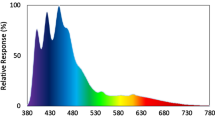Summary
-
1.
In contact with tissue of blastostyles buds of gasterozooids and regenerating gasterozooids will transform into blastostyles. The inductive capacity within blastostyles decreases from apex to base. Hypostomes with gasterozooid-like properties, which may frequently occur at the basal cut of isolated blastostyles, will transform into the homologous blastostyle structures in a sequence following that inductive gradient.
-
2.
The spontaneous transformation of regenerating gasterozooids into reproductive polyps, which could be observed during wintertime, can be increased by α-ketoglutarate (5×10−4 M/L), isocitrate (5×10−3 M/L), colcemide (3×10−6 M/L) and, with only weak effect, by CO2 increased top=2–4% Atm. With increasing dosages optimum lines could be determined. The transformable state of regeneration starts when tentacle formation takes place. By applying α-ketoglutarate in stepwise decreased concentrations 75 ppc transformations have been obtainable.
-
3.
If similarly applied in graduated dosages chromatographically separated blastostyle ectraxts also increase the rate of transformation. The causative factor is to be found in the range of fractions that also contains the tentacle-inducing substance.
Zusammenfassung
-
1.
In Kontakt zu Blastostylgewebe wandeln sich Nährpolypenknopen und regenerierende adulte Nährpolypen in Geschlechtspolypen um. Die Induktionsfähigkeit im Blastostyl nimmt von apikal nach basal ab. Am Basalende isolierter Blastostyle als anomale Regenerate erscheinende, Nährpolypen-typische Apikalstrukturen wandeln sich in einer dem Induktionsgradienten folgenden Sequenz in die homologen Blastostylstrukturen um.
-
2.
Die saisonal beobachtbare Umwandlung regenerierender Nährpolypen in Blastostyle wird durch α-Ketoglutarat (5×10−4 M/l), Isocitrat (5×10−3 M/L), Colcemid (3×10−6 M/L) und, in schwachem Maße, durch ein auf 2–4% Atm erhöhter pCO2 über die normale Häufigkeit erhöht. Dosierungsreihen ergeben Optimumskurven. Die sensible Regenerationsphase setzt mit der Tentakelbildung ein. Durch Applikation von α-Ketoglutarat in schrittweise abnehmenden Konzentrationen („Intervalltest“) lassen sich 75% Transformationen erzielen.
-
3.
Ebenso kann die Transformationsrate mit einer im Intervallverfahren applizierten Fraktion chromatographisch aufgetrennter Blastostyl-Extrakte erhöht werden. Das wirksame Agens liegt in jenem Fraktionsbereich, der die Tentakel-induzierende Substanz enthält.
Similar content being viewed by others
Literatur
Berill, N. J.: Growth, and form in gymnoblastic hydroids. VI. Polymorphism within Hydractiniidae. J. Morph.92, 241–274 (1953).
Braverman, M. H.: Studies in hydroid differentiation. I.Podocoryne carnea: Culture methods and carbon diocide induced sexuality. Exp. Cell Res.27, 301–306 (1962).
—: Studies on hydroid differentiation. II. Colony growth and the initiation of sexuality. J. Embryol. exp. Morph.11, 239–253 (1963).
Burnett, A., and N. Diehl: The nervous system of hydra. III. The initiation of sexuality with special reference to the nervous system. J. exp. Zool.157, 237–250 (1964).
—, W. Sindelar, and N. Diehl: An examination of polymorphism in the hydroidHydractinia echinata. J. mar. biol. Ass. U.K.47, 645–658 (1967).
Cazaud, Cl.: Facteurs de la morphogénése chez uu hydraire polymorphe,Hydractinia echinata. C. R. Acad. Sci. (Paris)247, 2195 (1958).
Daniaud, J.: Sur la morphogénése des dactylozooides d'Hydractinia echinata. C. R. Acad. Sci. (Paris)233, 758 (1951).
Hauenschild, C.: Genetische und entwicklungsphysiologische Untersuchungen über Intersexualität und Gewebeverträglichkeit beiHydractinia echinata. Wilhelm Roux' Arch. Entw., Mech. Org.14, 1–41 (1954).
—,, u. A. Kanellis: Experimentelle Untersuchungen an Kulturen vonHydractinia echinata zur Frage der Suxualität und Stockdifferenzierung. Zool. Jb., Abt. allg. Zool. u. Physiol.64, 1–96 (1953).
Loomis, W. F.: Control of sexual differentiation in hydra by pCO2. Ann. N. Y. Acad. Sci.77, 73–86 (1959).
—: Microenvironmental control of sexual differentiation in hydra. J. exp. Zool.156, 289–306 (1964).
Müller, W. A.: Untersuchungen zur Stockdifferenzierung vonHydractinia echinata. Zool. Jb., Abt. allg. Zool. u. Physiol.69, 317–324 (1961).
Müller, W. A.: Experimentelle Untersuchungen über Stockentwicklung, Polypendifferenzierung und Sexualchimären beiHydractinia echinata. Wilhelm Roux' Arch. Entw.-Mech. Org.155, 181–268 (1964).
—: Differenzierungspotenzen und Geschlechtsstabilität der I-Zellen vonHydractinia echinata. Wilhelm Roux' Arch. Entw.-Mech. Org.159, 412–432 (1967).
—: Die Steuerung des morphogenetischen Fließgleichgewichts in den Polypen vonHydractinia echinata. I. Biologisch-experimentelle Untersuchungen. Wilhelm Roux' Arch. Ent.- Mech. Org.163, 334–356 (1969a).
—: Die Steuerung des morphogenetischen Fließgleichgewichts in den Polypen vonHydractinia echinata, II. Chemisch-analytische Untersuchungen. Wilhelm Roux' Arch. Entw.- Mech. Org.163, 357–374 (1969b).
Author information
Authors and Affiliations
Additional information
3. Teil einer Arbeit, die der TU Braunschweig als Habilitationsschrift vorliegt.
Mit Unterstütung der Deutschen Forschungsgemeinschaft.
Rights and permissions
About this article
Cite this article
Müller, W.A. Determination der Geschlechtspolypen vonHydractinia echinata. Eine biologische und chemische Analyse. W. Roux' Archiv f. Entwicklungsmechanik 164, 37–47 (1969). https://doi.org/10.1007/BF00577680
Received:
Issue Date:
DOI: https://doi.org/10.1007/BF00577680




